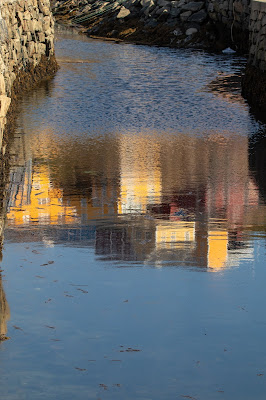A good morning for breakfast on the aft-deck - Sandy's special place.
Sisimiut lies just north of the Arctic Circle and is the northernmost town in Greenland where the port remains free of ice in the winter, and at the same time, it is the southernmost town in Greenland where it is possible to drive a dogsled in winter and springSisimiut means "the inhabitants at the foxholes". The town was founded in 1756 as a mission and trading station under the name Holsteinborg. However, the area has probably been a settlement site for more than 4,500 years.
I should have waited for the sun to move to take this picture.
The municipality of Sisimiut is Greenland's second largest municipality with 6,000 inhabit6ants living in the town itself along with the settlements of Kangerlussuaq, Safannguaq and Itilleq.
Fishing is the town't main industry.
We were given the option of a walk through the city with local guides and naturalists. A shorter city walk or a Photo walk with the Nat Geo Photo Team. The vivid colors of the community beckoned. The choice was a no-brainer. Our hike was not a "photography lesson" hike as I had anticipated. My first question: "what settings should I use to capture this scene?" was answered with "wait until the sun moves." Our group was quick spread about the length and breath of Sisimuit much to the chagrin of our guides. Photographers are not ones to follow a set pace when the prefect shot is at stake.
Sisimuit Church
Built in 1775 the blue church is Greenlands oldest church.The portal is made from whale jaw bones. Inside were two displays: one of the God-fearing church and the other of shamanism. Each featured an interactive video answering questions about traditional beliefs.
Schoolbell
A much photographed house. We were almost run over as we stood in the middle of the road trying to get the best angle and avoid the laundry hanging just below the red deck board. After only one night onboard, the idea that we would have to dodge traffic already seemed foreign.
There are about 1,000 sled dogs in Sisimuit. Most are chained out in a communal dog yard. Guess what these two were doing 2 foot from the road side when we walked up. I actually had to explain to my fellow photographers why they were facing different directions.
Sleds were stacked everywhere.According to Ehrlich in The Cold Haven: "Greenlandic dogs are descended from the first canine migrants who came to Greenland from Ellesmere Island. No other dogs are allowed into Greenland thus keeping the bloodlines pure. They pay attention only to the one who feeds them. Otherwise they are unconcerned with human affairs". Much to my joy, the Sisimuit dogs did respond to a universal canine howl I initiated.
Greenlandic sleds vary in size according to function and time of year. Sleds up to 18' long are used in spring to hunt narwhal when the sea ice is breaking up and for hauling large loads and crossing ice leads. Sleds for seal hunting and local and mountain travel are only 6 to 8 feet in length. Thule sleds were sometimes made of walrus bones with frozen peat runners and rolled hides or frozen fish as handles. A more modern sled on museum display (on the lower right) was the the only sled I saw the entire trip with runners and a bow bow. Greenlanders use a fan hitch system for their dogs and ride on or run beside their sleds.
This house with it's dog team was perched on top of the highest rock in town. I can not even imagine hooking up the team and flying down through town.
Kayak is an Inuit word. The local kayak club continues to make traditional skin covered kayaks and hold rolling competitions.
A local champion kayaker gave us a demonstration of numerous competitive methods of rolling a kayak.Kayak is an Inuit word. The local kayak club continues to make traditional skin covered kayaks and hold rolling competitions.
The full paddle
Under the boat roll.
After doing about a dozen rolls in the frigid water, he was as exhausted as we were impressed.
What would a photo essay of the arctic be without pictures of Arctic cotton?
My desk is decorated with samples from previous arctic trips.What would a photo essay of the arctic be without pictures of Arctic cotton?
Early homes were built with sod and rock walls. Some still remain intact.
Alas, full sim-cards in hand, it was back down the hill to the boat.First we were challenged to the best photo of the canal.
Mine won.
A last look at Sisimuit as we floated out of port.



























.jpg)




